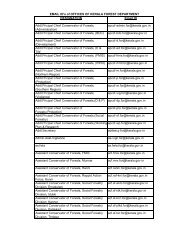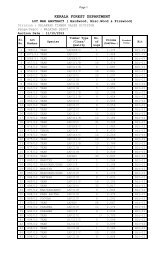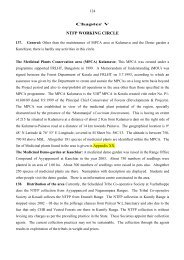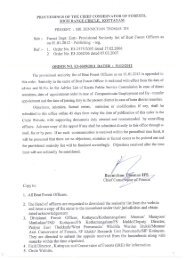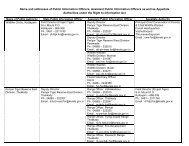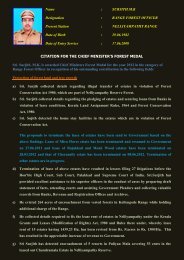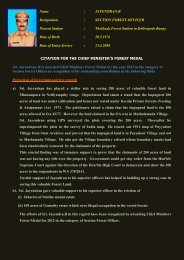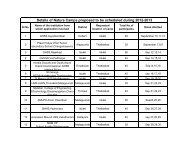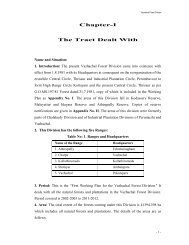Create successful ePaper yourself
Turn your PDF publications into a flip-book with our unique Google optimized e-Paper software.
Part I2AFOREST FLORA2.1:COMPOSITION AND CONDITION OFCROP:The tract dealt with in this working plan has alarge heterogeneity in the environmentalconditions. The complexity of physicalfeatures with corresponding variation in the macro<strong>and</strong> micro climatic conditions are expressed by avariety of plant formations. The composition of treesmet with in the tract is different in different types offorests, the details of which are furnished under para.2.2 Trees of all age classes are met with in the tract.The health <strong>and</strong> quality of the dominant <strong>and</strong>dominated trees are generally good, especially in theevergreen <strong>and</strong> semi evergreen portions. However,diseased trees, infected with parasites <strong>and</strong> pests areoccassinally met with in the natural forests.Scattered distribution of Bamboos, <strong>and</strong> reeds are seenin all the three Ranges. In Palappilly Range Canes arepresent over a small tract of about 200 ha. InPariyaram <strong>and</strong> Vellikulangara Ranges S<strong>and</strong>al woodpatches are available. Majority of the s<strong>and</strong>al areas arein Vellikulangara Range.The canopy is extremely dense, epiphytes arenumerous <strong>and</strong> woody climbers present. Groundvegetation may be generally absent. The tropicalwet evergreen forest is a climax type of vegetationunder the general climate of this region. Absence ofgregariousness in mature crop is a typical characterof this vegetation. The top canopy consists of loftytrees of evergreen species like Hopea parviflora,Dysoxylum malabaricum, Vateria indica, Artocarpushirsutus, Polyalthia fragrans, etc. The trees do notoccur in consociations. The component speciesregenerate under their own shade. But, species likeHopea, Vateria, <strong>and</strong> Euodia respond well toincreased light conditions while overhead light isdetrimental to the growth of Mesua ferrea <strong>and</strong>Dysoxylum malabaricum. This phenomena of coexistence of wide range of species with varyingdem<strong>and</strong>s of light conditions is termed as climaxtypes <strong>and</strong> this will continue to be stable if leftundisturbed.2.2 GENERAL DESCRIPTION OF GROWINGSTOCKThe dominant vegetation types prevail in thisDivision are 1. West coast tropical evergreen forests.(IA/c4) 2. West coast semi evergreen forests (2a/c2) 3.South India moist deciduous forests (3 B/C1) –Champion <strong>and</strong> Seth 1986-2.2.1 West Coast Tropical Evergreen<strong>Forest</strong>s (IA/C4): This type belongs to the maingroup “Tropical Wet Evergreen forests.” Thecharacteristics of this type of forests are loftyevergreen trees of height up to 45M. Consociations(gregarious dominants) are rarely met with <strong>and</strong>ordinarily, two third or more of the upper canopytrees are of species individually contributing not morethan one percent of the total number. A few species ofthe top storey are trees with 5m, or more in girth <strong>and</strong>may be briefly deciduous without affecting theevergreen nature of the forest as a whole.14Tropical Evergreen forestsDistribution: This type of forest is well representedin pockets of Njampara, Karimpadakallu inEchippara section of Palappilly Range,Komalappara, Kavala, Muduvarachal,Mayiladappan areas in Kavala section in
Part IVellikkulangara Range, <strong>and</strong> near Kurukkanpara,Vanchikadavu, <strong>and</strong> also along the right bank ofKannankuzhithodu of Kodassery section inPariyaram Range. Approximate extent of this type inthe Division is 3000 ha.Floristic Composition: Top Canopy: Hopeaparviflora, Dysoxylum malabaricum, Vateria indica,Palaquium ellipticum, Artocarpus hirsuta, Polyalthiafragrans, Lophopetalum wightianum etc. MiddleCanopy: Holigarna arnottiana, Myristica species,Terminalia bellirica, Vitex altissima, Hydnocarpusspecies, Ciannamomum Zeyalanicum, Macaranga peltata,Canarium strictum, etc. Bottom Canopy: Stobilanthus,Glycosmis pentaphylla, Curcuma species etc. Climbers:Calamus species, Smilax zeylanica, Entada species, Piperspecies etc.Ecological status: Though Evergreens are theclimatic climax type of forests in the tropical region,the type met with in this Division is only a degradedtype of tropical evergreen forests as a result of thevarious limiting factors such as annual fires, faultymanagement practices in the past, <strong>and</strong> the variousbiotic factors. If the area is not kept undisturbed,retrogression, which has already set in, will lead theforests to a much-degraded type.2.2.2 West Cost semi Evergreen <strong>Forest</strong>s.(2 A/C2): Tropical Evergreen forests, which aresubjected to heavy biotic interference in the past, havegradually transformed to this type. It is thus, atransitional stage from the evergreen to deciduousowing to change in environment. The speciesdiversity is high but less than that in the trueevergreens. Buttressed stems are frequent <strong>and</strong> occurin both evergreen <strong>and</strong> deciduous species. The generalcanopy is typically less dense than in the trueevergreen. Climbers, epiphytes are abundantincluding many ferns <strong>and</strong> orchids. Bamboos occur toa limited extent.Distribution <strong>and</strong> Extent: In the tract this type ofvegetation is generally met with on the eastern side ofValiyavara, on the banks of Anap<strong>and</strong>an Ar, on thenorth eastern side of Pindimudi in Palappilly Range,Irimpupara, Anap<strong>and</strong>am, Karikkadavu inVellikulangara Range, Krishnamudi, R<strong>and</strong>ukai areasof Pariyaram Range. This forest type extends over anapproximate area of 3300 ha.Semi Evergreen forestsFloristic composition: Top Canopy: Artocarpushirsutus, Machilus macrantha, Lagerstroemiamicrocarpa, Tetrameles nudiflora, Hopea parviflora,Terminalia paniculata, Bombax ceiba, Grewia tiliifolia,Pterocarpus marsupium Vateria indica, Dipterocarpusindicus. Middle Canopy: Polyalthia fragrans,Canarium strictum, Cinnamomum zeylanicum, Aporusalindleyana, Bridelia retusa, Emblica officinalis etc.Bottom Canopy: Strobilanthus species, Glycosmispentaphylla, Clerodendrun viscosum etc. Climbers:Butea parviflora, Spathalobus roxburgi, Calamussoecues, Entada sc<strong>and</strong>enf. etc.Ecological status: Tropical Evergreen <strong>Forest</strong>s,which are subjected to heavy biotic interference in15the past, have gradually transformed to this type.This forest type is thus a transitional stage from theEvergreen to deciduous, owing to changes in theenvironment.2.2.3 Southern Indian Moist Deciduousforests (3B/C1):This type of forests is met withgenerally in the rainfall zone of 1500 to 1800 mm asa transition zone between evergreen <strong>and</strong> drydeciduous forests. Although intimate mixture of thespecies is the rule, a relatively small number ofspecies together form the greater part of the canopy<strong>and</strong> relatively pure associations are frequently metwith. Some evergreen dominants are included butthey are few. The evergreen habits are moredeveloped in the lower storey giving the forests as awhole a more or less evergreen appearance most ofthe year. The distinct feature of this type is theleafless period during the dry season when theupper canopy is almost leafless. A good number oftrees flush into fresh leaves with the onset of thefirst pre monsoon showers. The lower canopy veryoften contains a mixture of deciduous <strong>and</strong>evergreen species. Annual fires are common featurein most of the area under this type, resulting in thegrowth of grass in open areas. Bamboo patches aremet with. Canes are restricted to wet regions <strong>and</strong>
Part Iepiphytes in damp shady places. Climbers areabundant <strong>and</strong> large.Distribution: The moist deciduous type has thewidest distribution <strong>and</strong> it occupies a greater portionof the major reserves. Extent: Approximate extent ofthis type is 8000 ha.Fig 2.<strong>Forest</strong> TypesTotal extent of Natural forests: 14284 haHa300033008000TypesEvergreen Semi evergreen Moist deciduousMoist Deciduous <strong>Forest</strong>Floristic Composition: Top Canopy: Terminaliapaniculata, Terminalia bellirica, Grewia tiliifolia, Adinacordifolia, Xylia xylocarpa, Bombax ceiba, Terminaliacrenulata, Tectona gr<strong>and</strong>is, Cedrela toona, Dalbergialatifolia, Lagerstroemia microcarpa etc. MiddleCanopy: Careya arborea, Cassia fistula, Dilleniapentagyna, Macaranga peltata, Strychnos nux- vomica,Emblica officianalis etc. Bottom Canopy: Helicteresisora, Eupatorium gl<strong>and</strong>ulosum, Glycosmis pentaphyllaetc. Climbers: Acacia intsia, Calycopteris floribunda,Butea parviflora etc.Ecological status: large extents of forests in thisDivision have been cleared for both forestry <strong>and</strong> nonforestry purposes, which has brought inenvironmental changes in the area. The rapiddenudation of the forests has changed soil condition<strong>and</strong> adversely affected the water regime. Thefrequent fire was a threat factor for the naturalregeneration. The net result was the generalretrogression of a wide extent of natural forests fromthe higher types such as evergreen or semi evergreenthat existed in this tract decades back. Therefore thistype of forests is termed as a biotic sub climax.2.2.4. Plantations: Extensive areas of thisDivision, especially of the moist deciduous typehave been converted into plantations of teak,softwood <strong>and</strong> miscellaneous species. The total areaunder teak plantations is 4535.42 ha, softwoodplantations (Teak & Elavu) 670.12 ha, pure Elavuplantations 107.80ha, pulpwood plantations 101.04ha, Bamboo plantations 38.60 ha, Cashewplantations 372.04 ha, <strong>and</strong> plantations of other misc.species 280.86 ha. As such, the total extent ofplantations in the Division is6105. 88 ha. In addition to the above, certain teakplantations of the Division are underplanted withother species like Bamboo, Cashew, Acacia, Mattyetc. The total extent of such plantations is 426. 24ha. The extent of under planted ares is overlappingwith the extent of teak plantations <strong>and</strong> as a matterof fact, the physical extent of all the plantationsincluding the under planted areas remain to be6105.88 ha as furnished above. List of plantations inthe Division is furnished as Appendix IX. Some of16the prominent miscellaneous species found in theseplantations are Terminalia tomentosa, Terminaliapaniculata, Lagerstroemia lanceolata, Bridelia retusa,Artocarpus hirsutus, Polyalthia fragrans, Dalbergialatifolia, Grewia tiliaefolia, Bombax malabaricum,Lagerstroemia lanceolata, Careya arborea, Macarangapeltata, Anogeissus latifolia, Cassia fistula, Albiziaodoratissima, Terminalia bellerica, Dillenia pentagyna,Schleichera oleosa, Aporusa lindleyana (Vetti,) Emblicaofficinalis, Cycas circinalis, Glycosmis pentaphylla,Helecteris isora, Eupatorium odoratum, Clerodendroninfortunatum, Phoenix species, Cymbopogon species.Cashew plantations: The total extent of CashewPlantations occurring in Palapilly <strong>and</strong>Vellikulangara Ranges is 432.10 ha. out of which,372.04 ha are pure cashew plantations <strong>and</strong> theremaining areas being under planting in the teakplantations. Cashew Plantations were raised under
Part ICashew afforestation scheme in the Division from1958 onwards. Major Cashew plantations in theDivision are at Vellupadam in Palappilly Range, <strong>and</strong>Areswaram, Mechira <strong>and</strong> Chettikulam inVellikulangara Range. The plantations are of mediumquality in terms of stock <strong>and</strong> yield.2.3 BAMBOO, RATTAN, REED, ANDSANDAL2.3.1 Bamboo: Bamboo is a promising renewablenatural resource requiring immediate attention. Thebenefits of bamboo are spread through employmentprovision, income generation <strong>and</strong> environmentprotection, mainly by its soil binding capacity. It is awell-known plant resource for faster growth, multipleuses <strong>and</strong> aesthetic beauty. In Kerala, major share ofbamboo resources are utilised by the pulp <strong>and</strong> paperindustry. Bamboo has become a dear commodity. Yet,entry of cash crops into the agricultural sector haspaved way for the disappearance of bamboo as acrop. There was over exploitation of bamboo forindustrial requirements resulting in the depletion ofthe resources. Countries having bamboo resourceshave now started utilising resources other thanbamboo for the production of pulp <strong>and</strong> paper,thereby taking a holistic approach towards thedevelopment of bamboo sector.Dendrocalamus strictus <strong>and</strong> Bamboosa arundinaceaeare the bamboo species available in ChalakudyDivision. At Valmukham, Kavala, Vanchikarvu,Pothupara, <strong>and</strong> Thenmudi para portions ofVellikulangara Range, at Valmukham, Parakadavu,Valiyakulam portions of Palappilly Range <strong>and</strong> atPeelarmoozhy, Kodakallu, Valara, Chikklayi,Cherumkayam, <strong>and</strong> Vanchikarvu portions ofPariyaram Range natural bamboo breaks are metwith. From Valmukham areas bamboo had beenextracted in the past. During 1979 <strong>and</strong> 80 the entirebamboo in the tract had flowered. The dead stock washarvested <strong>and</strong> at certain places there were subsequentnatural regeneration from the seeds off flowering. InVellikulangara Range bamboo is available only inKavala section.2.3.2 Reeds: Chalakudy forest Division supportsa limited extent of reed bearing areas. Small reedbreaks are met with in all the three Ranges. Reedbearing areas are confined mainly to the streambanks. The common species of Reed occurring in thisDivision is Ochl<strong>and</strong>ra travancorica, locally known asEetta. Also a more slender species, Ochl<strong>and</strong>rascriptoria, is found at places along certain rivercourses. At Valmukham, Kavala, Vanchikarvu,Pothupara, <strong>and</strong> Thenmudi para portions ofVellikulangara Range, at Valmukham, <strong>and</strong>Ettakomban portions of Palappilly Range <strong>and</strong> atPeelarmoozhy, Kodakallu, Valara, Cherumkayam,<strong>and</strong> Vanchikarvu portions of Pariyaram Rangereeds are met with2.3.3 Rattans: Rattans is a forest producttraditionally depended upon by rural people forsubsistence <strong>and</strong> for additional cash income. Rattan(cane) is a strong <strong>and</strong> medium-density wood, yetmuch lighter than wood <strong>and</strong> extremely pliable.Because of these desirable characters, it isextensively used in the manufacture of a wideRange of furniture <strong>and</strong> h<strong>and</strong>icraft items for low,medium <strong>and</strong> high-end markets. The wide Range ofuses resulted in dem<strong>and</strong>s coming from bothdomestic as well as international markets resultedin the over exploitation of canes. This, along withthe destruction of the natural forests has resulted insome useful rattans becoming scarce or even beingreduced to very low population levels in manyareas. The naturally available quantity of canes isnot sufficient to meet the increasing dem<strong>and</strong>s. Localscarcity of material is evident from the fact that,small-scale industries in Kerala are getting theirraw material supply from the north- eastern states,mostly from Assam. Augmenting the existingresources by large-scale cultivation in the naturalhabitat can minimize the wide gap betweendem<strong>and</strong> <strong>and</strong> supply.2.3.4 S<strong>and</strong>al areas: In Areswaram area, anextent of 12.5 ha had been taken up in themanagement plan period for intensivemanagement. In Chalakudy Division s<strong>and</strong>alwoodtrees are available in two Ranges, Vellikulangara<strong>and</strong> Pariyaram. Majority are in VellikulangaraRange. Natural s<strong>and</strong>al areas in VellikulangaraRange are, Mechira, Chunkal, Kanakamala,Chettikulam, <strong>and</strong> the s<strong>and</strong>al areas in PariyaramRange are, Pullumudi, Chakrani. There wereinstances of s<strong>and</strong>al wood offences in the Division<strong>and</strong> cases had been booked in both Ranges. Majoroffences related to s<strong>and</strong>alwood are in Chettikulamsection of Vellikulangara Range. In Chettikulamsection natural s<strong>and</strong>al is distributed over anapproximate extent of 500 ha. Most of thes<strong>and</strong>alwood areas are surrounded by habitations.172.4. STATUS OF NATURALREGENERATIONThe status of natural regeneration is not promisingin the semi evergreen <strong>and</strong> moist deciduous type offorests in Chalakudy Division, especially in thedegraded patches. The threat factors for the naturalregeneration are fire, weed growth consequent tothe opening in the canopy, grazing, draught etc.Grasses <strong>and</strong> weeds severely deprive youngregeneration of moisture, light <strong>and</strong> heat. Theclimbers smother <strong>and</strong> constrict plants, especiallyyoung ones, by climbing upon them resulting ingradual decrease in mean annual increment. Thecoarse grass may prevent light showers reaching
Part Ithe soil, transpire large quantities of water <strong>and</strong> henceincrease the danger of drought. Further, grass <strong>and</strong>weeds prevent fallen seeds of trees reaching the soil<strong>and</strong> suppresses growth of the younger plants. InChalakudy Division, damage to natural regenerationby weeds, climbers etc are seen in youngerplantations <strong>and</strong> also in natural forests. Prominentweeds are, Mikania, Lantana camera, Eupatoriumchinensis <strong>and</strong> Calycopteris floribunda. Lantana camera iswell adapted to tropical humid conditions prevalentin parts of Chalakkudy. Infestation by climberMikania macrantha in natural forests is severe. Itcovers vast areas within a short time, cuts sunlight,suppresses the host plants <strong>and</strong> eventually kills them.Various control measures have been researched <strong>and</strong>recommended for the control of these alien weedsincluding weeding, herbicides <strong>and</strong> classical biologicalcontrol with insect agents. Fire is another factordetrimental to the natural regeneration by exposingthe soil, which in turn leads to soil erosion <strong>and</strong> highwash-off. Drought alters the water balance in theplants. Increase in the evaporation <strong>and</strong> resultant lossof water is caused by prolonged dry spell. Hightemperature <strong>and</strong> drought prevent germination ofseeds <strong>and</strong> may even kill seeds, seedlings, older plants<strong>and</strong> at times even older trees. Grazing: This is severein forest areas adjoin the habitations. Cattle are oftenset free in groups to the forest areas, which usuallycause considerable damage to the regeneration byway of trampling seedlings <strong>and</strong> by hardening the soil.Goats <strong>and</strong> sheep browse the seedlings <strong>and</strong> tenderleaves <strong>and</strong> buds of many species. In the degradedforest patches the number of established seedlings perha is far from satisfactory ie. in many cases below400/ha. In the areas where Xylia dominates, however,high natural regeneration of the species is seen. Aregeneration survey has been conducted in thenatural forests of this division, the anlysis of whichhas been done in Para 8.4.1of <strong>Chapter</strong> 8, Part I of thisplan.However, the significance of mangroves as miraculouscoast guards has been proved in the Tsunami, occurredrecently in India, Sri Lanka <strong>and</strong> other countries. Thecoastal areas with mangrove vegetation served asshoreline protectors by st<strong>and</strong>ing as barriers againsttidal surges.In spite of all its values, even the remainingmangroves in Kerala continue to be under constantanthropogenic pressures. In Thrissur district alsothe situation is not different. The major mangroveareas of the district are at Chettuva near Thrissur. Afew mangrove patches however are available in theChalakudy forest Division areas as well, which areconfined mainly to Kodungallur portions. All themangrove patches in the Division are under privateownership. As anywhere else in Kerala, themangroves of this Division also face many threatfactors such as commercial exploitation of rawmaterials, l<strong>and</strong> reclamation for agriculture,aquaculture <strong>and</strong> housing etc.Table 5MANGROVE AREAS IN CHALAKUDYDIVISIONOwnershipAppr.ExtentLocalitPaily, Arackathara &others8ha Puthenchira P.O,KombattukadavuSimon,Mekkattuparambil 2 ha Do& othersM.X Davis,Mekkattuparambil 16 ha Do& othersNot known 6ha Naikkulangara,west ofThachappillybridgeNot known 12 ha Pethuruthu area2.5 ECO SYSTEMS OUTSIDE RESERVEDFORESTS2.5.1 Mangroves: The mangrove eco system inKerala had depleted heavily in the past severaldecades. The remaining mangrove patches have atotal extent of nearly 17 km 2 distributed in 8 coastaldistricts. Today the mangrove means the mangroveeco system. The mangrove plants <strong>and</strong> the associatedfauna <strong>and</strong> micro- organisms form the mangrove ecosystem. Each component of this eco system isinterdependent. This complex eco system, which is anatural reservoir of bio diversity, acts as a bridgebetween the terrestrial <strong>and</strong> aquatic eco systems. Thewide ranges of economical, ecological, <strong>and</strong> culturalaspects of mangroves are yet to be understood fully.18TOTAL44 ha2.5.2. The depletion of Mangroves <strong>and</strong>the reasons there of: There have beensignificant changes in the traditional <strong>and</strong> presentuses of resources within the mangrove ecosystem,which has much implication on its depletion. Forinstance, the traditional mangrove dwellers <strong>and</strong>stakeholders combined the uses of l<strong>and</strong>, sea, <strong>and</strong>inter tidal resources, were basically involved inprimary subsistence activities (eg.agriculture,fishing). Now, this trend has changed <strong>and</strong> asignificant number of them are associated withcommercial activities. The traditional mangrove ecosystem was, by <strong>and</strong> large, self-contained followingsubsistence production, but now it is closely relatedto market, resulting in its depletion. The other
Part Imajor causes of degradation of Mangroves in Keralaare the following• People poorly underst<strong>and</strong> mangrove eco systems.• L<strong>and</strong> reclamation for agriculture, aqua culture,<strong>and</strong> building construction.• Pollutants• Biotic reasons such as grazing, charcoal burning,cutting the woods for firewood <strong>and</strong> as feed forcattle• Construction of dams <strong>and</strong> barrages for irrigationpurpose deprive the mangrove vegetation of itsshare of fresh water. Increasing salinity leads togradual disappearance of species <strong>and</strong> also hasbeen responsible for change in speciescomposition.community assets. Kavus, irrespective of theownership status are under severe stress today.Encroachments in the form of exp<strong>and</strong>ingcultivation of crops, conversion of groves fortemple <strong>and</strong> other public uses are becomingcommon.Ward <strong>and</strong> Conner (1927) reported about 15,000sacred groves in Travancore <strong>and</strong> Cochin regions.Now we are having only 600 groves, of which 364are more than 200m 2 in extent. (Induchoodan 1996)Only two sacred groves remain in ChalakudyDivision, which are 1. Pambumekkavu owned bySri Sankaranarayanan Namboothiripadu, Vadamanear Mala (2ha) <strong>and</strong> 2. Mukundaswami templeKavu near Mala (1.5 ha)2.5.5. Causes for the depletion ofsacred groves:• Lack of tidal flushing leads to hyper salinecondition in the mangrove areas, which are alsoharmful to the mangrove vegetation• Coconut retting2.5.3: The Kole wet l<strong>and</strong>s: Kole wetl<strong>and</strong>s wasdeclared as Ramsar Site (Internationally importantwetl<strong>and</strong> habitat) in 2002 by the Wetl<strong>and</strong>sInternational <strong>and</strong> Ramsar convention taking intoaccount the biological diversity <strong>and</strong> socio-economicvalues of the system.The Kole wetl<strong>and</strong>s of Kerala, covering an area of13,632 ha, spread over Thrissur <strong>and</strong> Malapuramdistricts extending from the northern bank ofChalakudy River in the south to the southern bank ofBharathapuzha River in the north. (Fifty years back,the extent of kole l<strong>and</strong>s was more than 27,000 ha. inThrissur district alone) The area lies between 10 020’<strong>and</strong> 10 0 40’ N latitudes <strong>and</strong> 75 0 58’ <strong>and</strong> 76 0 11’ Elongitudes. A total of 233 species of birds in 60families have been reported from Kole wetl<strong>and</strong>s. Thebio diversity of Kole wet l<strong>and</strong>s has been discussed in detailin <strong>Chapter</strong> VI of Part <strong>II</strong> of this plan.2.5.4 Sacred groves: Sacred groves arefragmented forests, protected on religious grounds.They are patches of wilderness conserved for theirperceived importance attached to a village deity or aminiature evergreen forest within areas of humansettlements nurtured by tradition <strong>and</strong> sustained bybeliefs. Sacred groves, which were mainly familyowned properties, were once a common feature inevery village. As the families degenerated to smallerunits, the eldest male member usually retained theKavu. Many such individuals <strong>and</strong> at times even thefamilies were unable to maintain the Kavus properly,or to follow the Kavu rituals <strong>and</strong> as a result, thegroves were h<strong>and</strong>ed over to the Devaswom boards orto the local temple committees making them• Weakening of faiths, beliefs <strong>and</strong> taboos relatingto the sacred groves. The religious doctrine, onwhich the conservation of sacred groves hasbeen based, is getting eroded.• Introduction of l<strong>and</strong> reforms. After the l<strong>and</strong>reforms most of the serpent groves protectedby aristocratic <strong>and</strong> joint families have almostdisappeared.• High density of population <strong>and</strong> consequentpressure on l<strong>and</strong>.• Encroachment in the form of exp<strong>and</strong>ingcultivations.• Grazing, trespassing, collection of materials, inthe absence of physical <strong>and</strong> social fencing.• Invasion of exotic weeds.2.6. INJURIES TO WHICH CROP IS LIABLEA. ANTROPROGENIC INJURIES192.6.1 Man: Man is one of the important factorsresponsible for the degeneration <strong>and</strong> degradation offorests by way of encroachment, illicit felling, illicitbrewing, setting of fire, poaching etc. Clear felling<strong>and</strong> unscientific felling are sure to degrade forests.Failure to provide suitable environment for naturalregeneration, <strong>and</strong> defective cultural operationsresult in various setbacks both in natural forests<strong>and</strong> man made forests. Unregulated felling in thehills especially in catchment areas, clear felling invery steep slopes, excessive exercise of rights or
their abuse can definitely lead to destruction offorests.2.6.2 Fire: The deciduous forests are particularlysubjected to annual fire during the dry months of theyear. It causes considerable damage to theregeneration <strong>and</strong> exposes soil, resulting in soil erosion<strong>and</strong> high wash-off. The largest single factor, whichcauses damage to the forests, is fire. The graziers whoset fire to the grass for promoting fresh shootingcause deliberate fires. People engaged in the collectionof non-wood forest produce also cause fire to thevegetation as a whole, or to the individual trees, tofacilitate collection of the produce. Agriculturists setfire to the vegetation during the months before rainswith a view to generate ash, which subsequentlyduring the rains, are washed down to the farmyards.Usually there is no crown fire in plantations.However, the ground fire is common annually, whichdepletes the dry organic materials. Ground fire alsohastens the drying up of wind fallen trees <strong>and</strong>undergrowths which results a second fire in April orjust before the pre monsoon showers. In such areaswhere, fire occurs for the second time in a year,certain trees develop internal defects <strong>and</strong> becomehollow. Fire, whatever may be its form, ground orcrown, retards the growth.2.6.3.Fire prone areas:Palappilly Range: Valiyakavu, cheenikkunnu, kallai,Punnamattom Vellikulangara Range: Kanakamala,Mattathur kunnu, Vellaram padam, Kannattupadam,Inchakkunnu Pariyaram Range: Mullappana,Karikkadavu, Veeranchira, Karikkattoli, Vettilappara,<strong>and</strong> ChaippinkuzhiStatistics of fireStatistics of fire occurrence in any forest Division donot always denote the true extent of damage <strong>and</strong>more often taken for granted in most areas. Damagedone by fire to the growing stock in monetary terms isnot available. Details of occurrence of fire in theDivision furnished in Appendix X2.6.4 Illicit fellings: Illicit felling takes place inthe natural forests <strong>and</strong> plantations is another factor,which has been injurious to the crops. Illicit fellingsare often related to timber smuggling, illicit liquorbrewing in the forests etc. For illicit collection offirewood for household cooking also st<strong>and</strong>ing treesare felled. A statement showing the details of forestoffences booked in the Division for the last 10 yearsindicates that, there is a steady decrease in theoccurrence of offences, especially since the year 2000.But, during this period there was not any substantialimprovements in the working facilities of the20Part Iprotective staff, nor was there any increase in thestrength of protective personnel. As such, thereduced number of offences could be attributed tothe increased labour opportunities available to thelocal people. Range wise details of forest offencesfor the last 10 years furnished in Appendix XI2.6.5: Illicit Brewing in the forests, <strong>and</strong>Ganja cultivation: The degradation of forestsis often attributed to illicit felling of trees. Timbersmugglers, local people who collect firewood forhousehold cooking, <strong>and</strong> in certain portions of thedivision the illicit liquor brewers, cause illicit fellingof trees. <strong>Forest</strong> areas provide more suitableconditions than the non-forest areas forunauthorised brewing of liquor, mainly because itis easier to escape notice of the Police <strong>and</strong> Exciseauthorities, <strong>and</strong> also in view of the easy availabilityof firewood in large quantities required for thedistillation. In the Reserved <strong>Forest</strong>s ofChaipankuzhy beat of Kormala section evidences ofillicit brewing are lavish through out the forestareas especially in the plantation portions <strong>and</strong>beside the streams. It has been seen that, to store thewash (The crude mixture of ingredients in liquidform which is subsequently subjected todistillation) in huge quantities, large trenchesprovided with lining of plastic sheets are beingused, from where the wash is taken to thedistillation points by means of rubber tubes. As alot of water is required for distillation, this processoften takes place beside the streams <strong>and</strong> streamlets.Firewood required for the distillation is collected bycutting down valuable trees, often from the nearestareas. Teak, being ideal for firewood purpose, isoften preferred by the brewers over other species.Similarly, cultivation of Ganja, though not frequent,has been reported in the past from certain portionsof the Division. It is the Kavala section inVellikulngara Range, which is prone to Ganjacultivation in view of the relatively more suitablegeographic features of the section.To curb the above situations effectively, protectionhas to be strengthened by participation of thepeople. More Vana Samrakshana Samithies (VSS)have to be constituted in such sensitive areas <strong>and</strong>the activities of the existing VSS should be reoriented to deal with such issues.
No. of offencesFig 3.Chalakudy Division<strong>Forest</strong> Offences from 1994 to 20046146 4478574134243816 9Part I(Elephas maximus), wild boar, rodents, deersespecially the Sambar, <strong>and</strong> porcupines are the onescausing damages to the plantations. Elephantdamages teak plantations by uprooting trees,trampling seedlings, peeling the bark of poles,which is relished by them, <strong>and</strong> breaking downsaplings. Sambar also injures trees by rubbing theirhorns against the bark <strong>and</strong> browsing seedlings ofcertain species.2.6.11. Pests <strong>and</strong> diseasesYear1994 1995 1996 1997 1998 19992000 2001 2002 2003 2004B. INJURIES DUE TO NATURAL CAUSESFollowing are the major pests of the divisioncausing considerable damages to the teakplantations.2.6.11.1. Alcterogystia cadambae: This is arelatively new insect pest that has attained a seriouspest status in some plantations in Kerala,Tamilnadu <strong>and</strong> Karnataka states (Mathew1990).2.6.6: Drought: Increase in evaporation <strong>and</strong>resultant loss of water is caused by prolonged dryspell. Drought alters the water balance in the plants.High temperature <strong>and</strong> drought prevent germinationof seeds <strong>and</strong> may even kill seeds, seedlings, olderplants <strong>and</strong> at times even older trees. In general, itreduces the increment, induces premature leaf fall<strong>and</strong> increases fire hazard. The drought-affected plantsare generally more susceptible to attack by pests <strong>and</strong>diseases. Drought in the form of delayed monsoonsmay be harmful for artificial regeneration operations.2.6.7 Wind: Wind generally causes physical injuryto the forests, where soil is shallow. Severe wind alsoalters the fine characteristics of timber. It enhancestranspiration, drying out of the soil as well asuprooting <strong>and</strong> breaking of the trees at times.However, damage caused by wind is not of muchsignificance in this Division. Winds disburse theseeds of weeds <strong>and</strong> as such may result in spreading ofweeds.2.6.8 Flood: The floods during the southwest<strong>and</strong> the northeast monsoons erode the banks of rivers<strong>and</strong> uproot the trees along the riverbanks.2.6.9 Grazing: This is severe in forest areas adjointhe habitations. Cattle are often set free in groups tothe forest areas, which usually cause considerabledamage to the regeneration by way of tramplingseedlings <strong>and</strong> by hardening the soil. Goats <strong>and</strong> sheepbrowse the seedlings <strong>and</strong> tender leaves <strong>and</strong> buds ofmany species. The branches of trees such as Venga,Anjily, etc. are also lopped off for fodder.2.6.10 Wildlife: Wildlife cause occasionaldamages to the seedlings <strong>and</strong> poles both in thenatural forests <strong>and</strong> also in plantations. Elephant21A Teak tree attacked by Alcterogystia cadambaeThe caterpillars of this insect are wood boring inhabit, attacking st<strong>and</strong>ing trees, riddling the woodwith larval tunnels <strong>and</strong> causing die back. Severalcaterpillars may attack the same treessimultaneously at different places or the affectedtree may be subjected to re infestation in succeedingyears. Attack by Alcterogystia cadambae was firstreported from Chalakudy <strong>and</strong> Thrissur forestdivisions in Kerala.Studies on the distribution, host range, <strong>and</strong>progression of infestation of teak borer,Alcterogystia cadambae (Moore) were made by thedivision of entomology, KFRI, Peechi. The excerptof the study report pertains to Chalakudy divisionshows that, the infestation level is heavy in theplantations subjected to study.
Part IThe data collected reveal a rapid spread of infestationduring the study period. When the study wasinitiated 61 % of the trees were affected which became90% at the end of study period. Annually 14.5 % ofthe trees acquired fresh infestation. The excerpt of thestudy report, pertains to Chalakudy division isfurnished as Table No 6.Name ofplantationTable 6INFESTATION LEVEL OF PESTALCTEROGYSTIA CADAMBAECHALAKUDY DIVISIONYear ofplantingExtentInfestationlevelRamavarma 1931 23.47 ++Veluppadam 1927 29.54 ++Veluppadam 1961 24.43 ++Cheenikunnu 1955 32.49 +Do 1959 126.76 +Do 1960 43.08 +Pulikkani 1925 12.07 ++Do 1926 16.60 ++Do 1928 17.47 ++Do 1928 7.10 ++Kuttanchira 1935 92.58 ++Do 1938 23.48 ++Kanattupadam 1936 24.24 ++Vettingapadam 1963 8.60 +Do 1921 2.06 +Karikkulam 1946 16.87 +Do 1947 10.29 ++ moderate++ heavyInstances of the pest attacking Grewia teliafolia, <strong>and</strong>Terminalia bellerica was observed in Palappilly rangeduring the studies. Unsuccessful attempts of larvalestablishment had been noticed on Bridelia squamosa atVadakkanchery <strong>and</strong> on Xylia xylocarpa in Palappilly. Theobservations indicate that, teak is the principal host of A.cadambae in Kerala <strong>and</strong> its choice of alternate hosts israther limited unlike other cossid pests (George Mathew,1991)2.6.11.2. Hyblaea puera (The defoliator):Defoliation of teak by the insect Hyblaea puera is aregular annual feature in most teak plantations inIndia. Chalakudy division is not an exemption. Thesedefoliator pests attack young leaves <strong>and</strong> there byaffect the growth of teak trees in natural forests <strong>and</strong>plantations. Some of the insects act as vectors inspreading plant diseases2.6.11.3. Sahyadrassus malabaricus (The saplingborer): This pest is a sapling borer of teak, attackingyoung plants sporadically in the teak plantations ofSouth India. This pest is noticed in Chalakudydivision as well.2.6.11.4 Eutectona machaeralis (Theskeletonisor): Unlike the defoliator, theskeletonisor eats only the leaf lamina leavingbehind the veins <strong>and</strong> veinlets. Yet, this is one of themost destructive pests of teak.2.6.12 Grass, weeds, <strong>and</strong> climbers:Grasses <strong>and</strong> weeds severely deprive youngregeneration of moisture, light <strong>and</strong> heat. Theclimbers smother <strong>and</strong> constrict plants, especiallyyoung ones, by climbing upon them resulting ingradual decrease in mean annual increment. Thecoarse grass may prevent light showers reachingthe soil, transpire large quantities of water <strong>and</strong>hence increase the danger of drought. Further,grass <strong>and</strong> weeds prevent tree seeds reaching thesoil cover <strong>and</strong> suppresses growth of the youngerplants. They promote chances of forest fires, aswell. In Chalakkudy Division, damage due toweeds, climbers etc are seen in younger plantations<strong>and</strong> also in natural forests. Prominent weeds are,Mikania, Lantana camara, Eupatorium chinensis <strong>and</strong>Calycopteris floribunda. Lantana camara is welladapted to tropical humid conditions prevalent inparts of Chalakkudy. Loranthus longifolius,Eupatorium chinensis <strong>and</strong> Calycopteris floribunda arecommon in teak <strong>and</strong> softwood plantations.Removal of the same is necessary to preventretardation of growth <strong>and</strong> loss of incrementresulting from these parasites. Common parasiteplant is Loranthus. Infestation by climber Mikaniamicrantha in younger plantations, reed brakes <strong>and</strong>even natural forests is rampant; it covers vast areaswithin a short time, cuts sunlight, suppresses thehost plants <strong>and</strong> eventually kills them by the tenthouse effect. Various control measures have beenresearched <strong>and</strong> recommended for the control ofthese alien weeds including weeding, application ofherbicides <strong>and</strong> classical biological control withinsect agents. Unfortunately, none of these hasresulted in any substantial impact on either thedistribution or abundance of the weeds. This islargely because of the regional nature of theproblems; weeding <strong>and</strong> application of herbicidesare difficult to implement on a large scale <strong>and</strong>broad applications of herbicides are alsoundesirable because of possible effects on localcommunities <strong>and</strong> native flora <strong>and</strong> fauna. Also, littleeffort has been put towards identifyingcomplementary herbivores that hit critical stages ofthe life cycles of the weeds. Likewise, little effort22has been made to examine the possibilities of usingindigenous or exotic host specific pathogens.However, in the natural forests, especially in semievergreen<strong>and</strong> evergreen, infestation is high alongthe periphery of the forests, <strong>and</strong> is very sparse or
Part Irather absent in the interior parts of the forests wherethe canopy is closed.The way Mikania kills the regenerationMikania micrantha H.B.K., which originates from thetropical <strong>and</strong> subtropical zones of north, central <strong>and</strong> southAmerica, is a perennial weed of the family Asteraceae(Holm. Et al., 1977). It is widespread in a number ofcountries within the moist tropical zones of Southeast Asia<strong>and</strong> the Pacific <strong>and</strong> is still exp<strong>and</strong>ing its Range(Waterhouse, 1944). The weed has been present in Indiasince the early 1940’s. Thence, it has dramaticallyincreased its range within India causing damage to treecrop <strong>and</strong> agroforestry/ multipurpose trees in moist tropicalforest zone of southwest <strong>and</strong> northeast India (Choudhury,1972; Muniappan <strong>and</strong> Viraktanath, 1993). It is known tooccur in the States of Assam (Choudhury, 1972), WestBengal (Palit, 1981), Tripura, Manipur, Kerala (Nair,1988), Arunachal Pradesh (Beniwal, 1987), Orissa(Subudhi <strong>and</strong> Dixit, 1998) <strong>and</strong> in the Union Territory ofAndaman And Nicobar Isl<strong>and</strong>s (Singh et al., 1989). InKerala, the weed is known by different local names viz.,mayakkuvally, silkuvally, kaipuvally, americanvally, etc.Mikania micrantha (hereafter referred as Mikania) isreported to be deliberately introduced into the northeasternpart of India during the Second World War as a nonleguminousground cover for tea plantations (Parker,1972; Borthakur, 1977; Palit, 1981). It was first observedin the Western Ghats Region (WGR) in the 1980’s In India,tree crops seriously affected by the weed include teak(Tectona gr<strong>and</strong>is L.) (Palit, 1981), Eucalyptus tereticornisSm., bamboo (Bambusa arundinacese (Retz.) Willd.,Dendrocalamus strictus (Roxb.) Nees), reeds (Ochl<strong>and</strong>raspp.) Nair, 1988) <strong>and</strong> Ailanthus triphysa (Dennst.) Alston(Varma, 1991) <strong>and</strong> Acacia auriculiformis Cunn.ex G.Don.). Mikania also affected subsistence crops grown inshort rotation shifting agricultural systems in northeastIndia (Swamy <strong>and</strong> Ramakrishnan, 1987 a). Amongcommercial <strong>and</strong> homestead crops, tea, coffee, pineapple,banana, cassava <strong>and</strong> ginger are under serious treat due tothe weed. It is also known to invade forests in southeast <strong>and</strong>northeast India (Choudhury, 1972; Parker, 1972; SenSharma <strong>and</strong> Mishra, 1986).



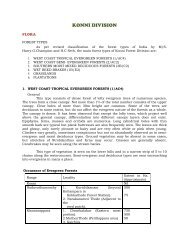
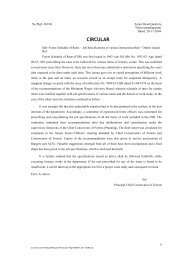
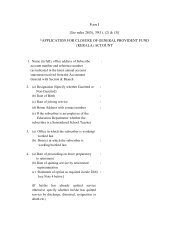
![[See rules 14 & 37(1)] FORM OF APPLICATION FOR TEMPORARY ...](https://img.yumpu.com/49611345/1/190x245/see-rules-14-371-form-of-application-for-temporary-.jpg?quality=85)
